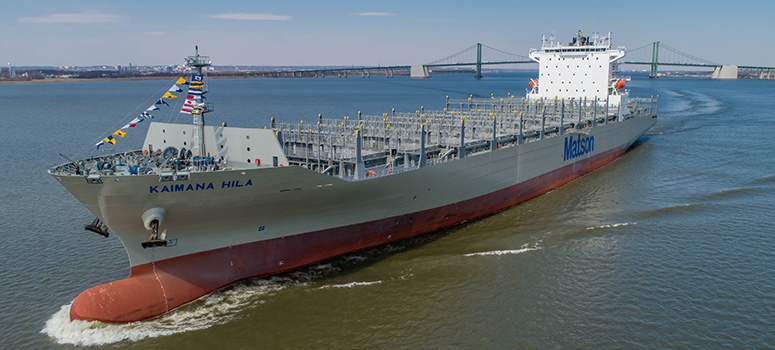As this column has recently documented, the ocean carrier industry remains in the throes of a seemingly unending cycle of rate erosion, vacant sailings and dysfunctional relationships with shippers and other stakeholders.

Oakland-based Matson recently christened the Kaimana Hila, the second of two Aloha class containerships. These ships represent the largest vessels to have been built in the United States. Photo courtesy of Matson
BY PATRICK BURNSON
Published: May, 2019
As this column has recently documented, the ocean carrier industry remains in the throes of a seemingly unending cycle of rate erosion, vacant sailings and dysfunctional relationships with shippers and other stakeholders.
But there have been exceptions to this sorry state of affairs, with one outstanding example here in the Bay Area. Rising above the chaos is Oakland-based Matson, a leading U.S.-flag carrier in the Pacific, which recently christened the second of two Aloha class containerships, which are the largest vessels ever to have been built in the United States.
The new vessel, named Kaimana Hila, is the sister ship to Daniel K. Inouye, which was christened in June and went into service in November 2018. “Kaimana Hila” is a Hawaiian transliteration of “Diamond Head,” the name of Hawaii’s iconic landmark crater near Waikiki Beach.
The two ships were built for Honolulu-based Matson by Philly Shipyard, Inc. (PSI), the wholly-owned U.S. subsidiary of Philly Shipyard ASA, and comes at a time when the Jones Act is again being threatened by misguided politicians who feel that U.S.-flag shipping is a vestige of the past that should be scrapped.
Countering that sentiment is Steinar Nerbovik, Philly Shipyard president and CEO, who said that the construction of the Kaimana Hila, and its earlier sister ship, has provided good skilled work for nearly 1,500 people at Philly Shipyard over the last three years.
Patrick Burnson is the executive editor of Logistics Management. www.logisticsmgmt.com
“We are immensely proud to provide another quality and safe vessel that Matson can be proud of for years to come,” Nerbovik said.
Weighing in at over 51,400 metric tons, the 850-foot long and 3,600 twenty-foot equivalent units (TEUs) capacity Kaimana Hila and Daniel K. Inouye are also Matson’s fastest vessels, with a top speed of nearly 24 knots, helping ensure on-time deliveries in Hawaii from Matson’s three West Coast terminals in Seattle, Oakland and Long Beach.
In addition, both Aloha class vessels incorporate the latest environmentally friendly technology, including dual-fuel engines that can be adapted to use liquefied natural gas (LNG), double-hull fuel tanks, fresh-water ballast systems and a more fuel-efficient hull design.
This comes at a time when ocean carriers in other trade lanes are mired in debt while trying to adhere to stringent new energy standards soon to be imposed by the International Maritime Organization.
Furthermore, with the International Longshore and Warehouse Union resisting automation at other terminals, Matson may enjoy a favored status with dockworkers thanks to the fact that it owns a 35 percent interest in SSA Terminals, the leading U.S. West Coast terminal operator.
Daniel Smith, a principal of the Tioga Group, further noted that Matson has not needed automation to date and probably doesn’t for the near future, as it provides terminal and stevedoring services to carriers at seven key facilities.
“Their terminals operations are simpler and self-contained,” he said, “and do not have truck dwell time issues that others must face.”
Port of Oakland Reports Positive First Quarter
The Port of Oakland today reported a positive first quarter in its cargo volume. Through the end of March 2019, the port handled 612,151 TEUs, compared to 587,356 during the same period in 2018. That represents a 4.2 percent increase.
Port spokespeople said that there has been “some concern” in the shipping industry that a recent import surge has cooled. This thrust was caused by shippers last year trying to get ahead of possible new tariffs affecting U.S.-China trade.
“Though the import rally has calmed down, we are still seeing a strong consumer demand in Northern California and Nevada,” said Port of Oakland Maritime Director John Driscoll. “The Bay Area’s strong consumer-based economy has helped the Port of Oakland absorb the impact of the weakening rally better than other ports.”
Last month, Oakland handled 213,972 TEUs, compared to 193,341 in March 2018. That represents at 10.7 percent increase. Loaded exports also grew 7.6 percent last month compared to March 2018.
The port’s communications director, Mike Zampa, said that while he is encouraged to see a return to growth last month, all bets are off for now.
Patrick Burnson is the executive editor of Logistics Management. www.logisticsmgmt.com

